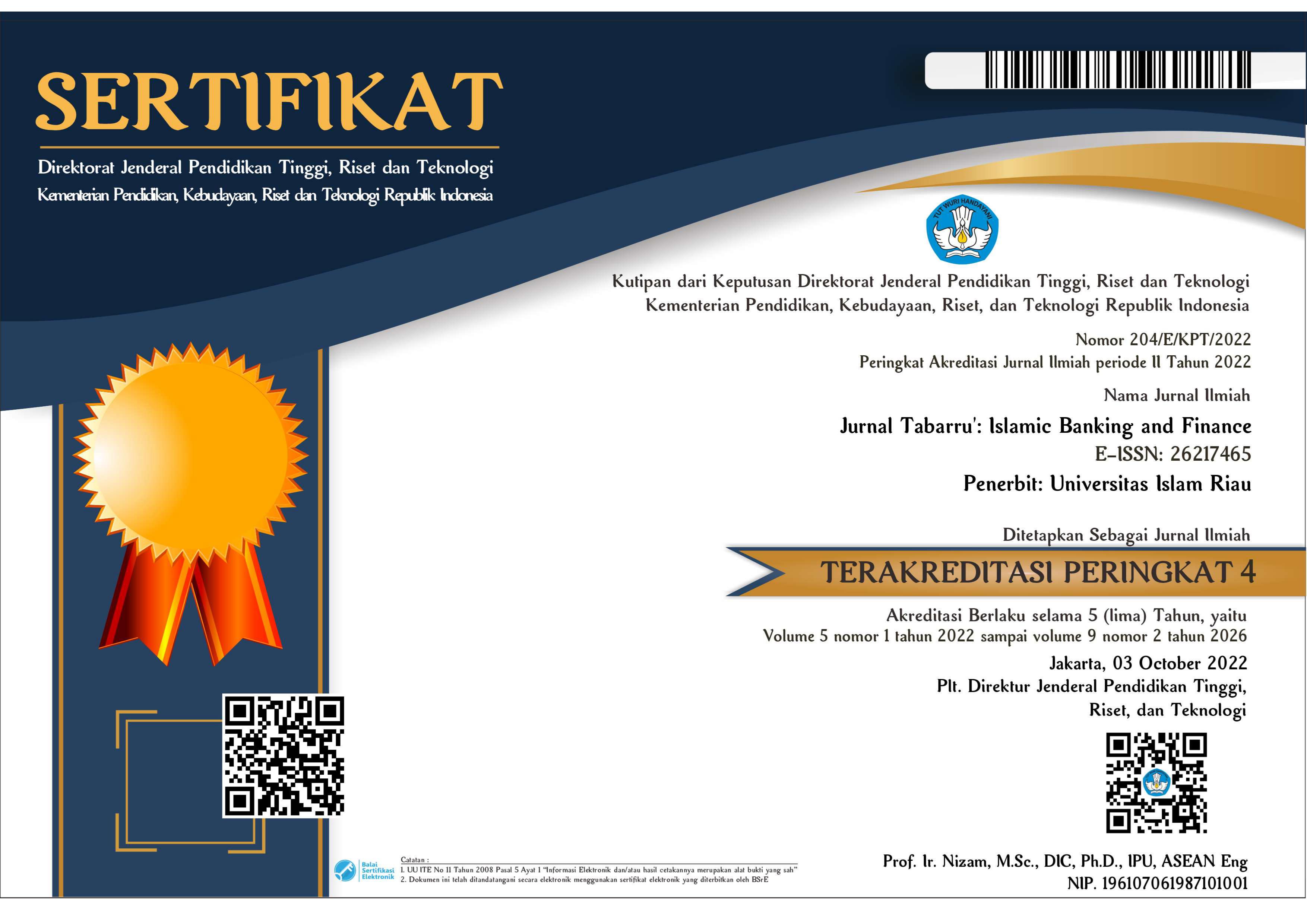Author Guidelines
Manuscript
- Topics to be published by Journal Tabarru' related to ideas or issues in Islamic Banking and Finance, Management Zakat Fund, Management Waqaf Fund, Islamic Accounting, and Islamic Financial Management.
- The manuscript is written in standard Indonesian or English, has never been published, and is free of plagiarism. The manuscript has a written statement sent via email to tabbaru@journal.uit.ac.id.
- Manuscript typed with the computer using Microsoft Word (Doc) 2 Column, on paper size 21 cm x 29.7 cm (A4), 1,5-spaced and in 12 point Times New Roman font. There should be a top and a bottom margin of 3.0 cm, with right and left margins of length 3.15 cm.
- The number of pages ranges from 10-15 pages, and the number of images should not exceed 30% of all posts
- The author's name is written under the title before the abstract without any academic degree or any other degree, from the institution where the author takes shelter and email address for correspondence with the size of 11 bold points.
- Systematic scriptwriting, consisting of:
Abstracts and keywords
Abstracts are written in Indonesian and English with lengths of 150-200 words each and are tilted with Times New Roman 11 typed points with 1 spacing in 1 paragraph. The abstract is arranged with short sentences, clear, coherent, and systematic, and can describe the research process from the background, objective, method, research implementation, to the conclusion of the research result.
Introduction
The introduction contains brief and concise research backgrounds, and objectives. Theoretical support is included in this section, and similar research that has been done can be stated.
Research Methods
This section contains a complete and detailed description of the steps undertaken in conducting research. In addition, the research step also needs to be shown in the form of a flowchart of the research or framework step in complete detail including reflected algorithm, rule, modeling, design, and others related to the system design aspect.
Results and Discussions
Results and Discussion is a section that contains all scientific findings obtained as research data. This section is expected to provide a scientific explanation that can logically explain the reason for obtaining those results that are clearly described, complete, detailed, integrated, systematic, and continuous.
The discussion of the research results obtained can be presented in the form of a theoretical description, both qualitatively and quantitatively. In practice, this section can be used to compare the results of the research obtained in the current research with the results of the research reported by previous researchers referred to in this study. Scientifically, the results of research obtained in the study may be new findings or improvements, affirmations, or rejection of a scientific phenomenon from previous researchers.
Conclusion and Suggestion
This section contains conclusions and suggestions. The conclusion is a brief, clear, and precise statement of what is obtained contains advantages and disadvantages, can be proven, and is directly related to the purpose of the research. The suggestion is a follow-up study that is still needed to refine the results of the research in order to be efficient.
Reference/Bibliography
The References list contains only the literature that is really referred to in Times New Roman 12-point paper, and is compiled as follows:
- The References List is based on the order in which the references appear.
- Writing for a single typed one-space source library. The distance between the sources of libraries remains two spaces.
- The source of reference from the Internet should come from an official scientific article.
- Each library is written according to:
- Books: writer’s name, publishing year, title, edition (if necessary), volumes (if necessary), name of publisher, publisher city
- Magazine / Journal Scientific / Proceedings: writer’s name, publishing year, title, name of magazine / scientific journal/proceedings, edition (if necessary), name of publisher, publisher city
The sample of reference
[1] S.K. Robert. 2015. The Implication of Using Social Media in Business. Gramedia. Jakarta.
[2] P.M. Morse and H. Feshback. 2016. Effect of Corporate Social Responsibility on Company Performance. Journal of Economics, 3(2), p. 201-212.
Author Fees




 Asosiasi Program Studi Keuangan dan Perbankan Syariah
Asosiasi Program Studi Keuangan dan Perbankan Syariah The Jurnal Tabarru' site and its metadata are licensed under CC BY-SA
The Jurnal Tabarru' site and its metadata are licensed under CC BY-SA